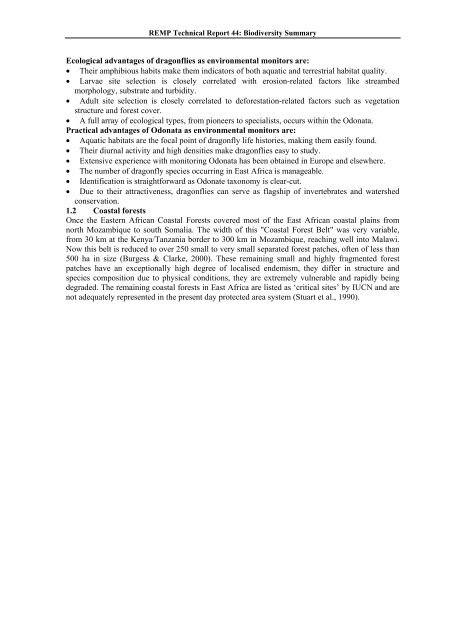Family / Scientific name - Coastal Forests of Kenya and Tanzania
Family / Scientific name - Coastal Forests of Kenya and Tanzania
Family / Scientific name - Coastal Forests of Kenya and Tanzania
You also want an ePaper? Increase the reach of your titles
YUMPU automatically turns print PDFs into web optimized ePapers that Google loves.
REMP Technical Report 44: Biodiversity Summary<br />
Ecological advantages <strong>of</strong> dragonflies as environmental monitors are:<br />
�� Their amphibious habits make them indicators <strong>of</strong> both aquatic <strong>and</strong> terrestrial habitat quality.<br />
�� Larvae site selection is closely correlated with erosion-related factors like streambed<br />
morphology, substrate <strong>and</strong> turbidity.<br />
�� Adult site selection is closely correlated to deforestation-related factors such as vegetation<br />
structure <strong>and</strong> forest cover.<br />
�� A full array <strong>of</strong> ecological types, from pioneers to specialists, occurs within the Odonata.<br />
Practical advantages <strong>of</strong> Odonata as environmental monitors are:<br />
�� Aquatic habitats are the focal point <strong>of</strong> dragonfly life histories, making them easily found.<br />
�� Their diurnal activity <strong>and</strong> high densities make dragonflies easy to study.<br />
�� Extensive experience with monitoring Odonata has been obtained in Europe <strong>and</strong> elsewhere.<br />
�� The number <strong>of</strong> dragonfly species occurring in East Africa is manageable.<br />
�� Identification is straightforward as Odonate taxonomy is clear-cut.<br />
�� Due to their attractiveness, dragonflies can serve as flagship <strong>of</strong> invertebrates <strong>and</strong> watershed<br />
conservation.<br />
1.2 <strong>Coastal</strong> forests<br />
Once the Eastern African <strong>Coastal</strong> <strong>Forests</strong> covered most <strong>of</strong> the East African coastal plains from<br />
north Mozambique to south Somalia. The width <strong>of</strong> this "<strong>Coastal</strong> Forest Belt" was very variable,<br />
from 30 km at the <strong>Kenya</strong>/<strong>Tanzania</strong> border to 300 km in Mozambique, reaching well into Malawi.<br />
Now this belt is reduced to over 250 small to very small separated forest patches, <strong>of</strong>ten <strong>of</strong> less than<br />
500 ha in size (Burgess & Clarke, 2000). These remaining small <strong>and</strong> highly fragmented forest<br />
patches have an exceptionally high degree <strong>of</strong> localised endemism, they differ in structure <strong>and</strong><br />
species composition due to physical conditions, they are extremely vulnerable <strong>and</strong> rapidly being<br />
degraded. The remaining coastal forests in East Africa are listed as ‘critical sites’ by IUCN <strong>and</strong> are<br />
not adequately represented in the present day protected area system (Stuart et al., 1990).

















